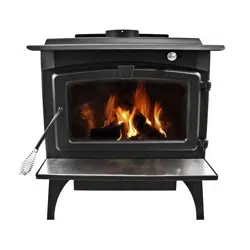Loading ...
Loading ...
Loading ...

15
2. Remove screw and glass clip.
3. Lift glass out from glass clip.
4. Remove old gasket and clean glass.
5. Replace new gasket starting at the bottom of glass
working along edges, being sure to centre gasket
channel on glass.
6. Trim to length and butt ends together.
7. Replace glass in door, being sure not to over-tighten
screw and clip.
The following steps should be followed for door gasket
replacement:
1. Ensure appliance is not in operation and is thoroughly
cooled.
2. Remove old door gasket and clean channel.
3. Using an approved high temperature gasket cement,
apply a thin coat in bottom of channel.
4. Starting at hinge side of door, work into channel
around door unit, end butt and trim to length.
5. Close door and allow three to four hours for cement
to set before restarting appliance.
CREOSOTE
Creosote - Formation and Need for Removal
When wood is burned slowly, it produces tar and other
organic vapors, which combine with expelled moisture
to form creosote. The creosote vapors condense in the
relatively cool chimney flue of a slow-burning fire. As a
result, creosote residue accumulates on the flue lining.
When ignited this creosote makes an extremely hot fire.
The chimney connector and chimney should be inspect-
ed at least once every two months during the heating
season to determine if a creosote buildup has occurred.
If creosote has accumulated (3 mm or more) it should be
removed to reduce the risk of a chimney fire.
WAYS TO PREVENT AND KEEP UNIT FREE OF CREOSOTE
1. Burn with air control open for several minutes at
numerous intervals throughout the day during the
heating season, being careful not to over-fire unit.
This removes the slight film of creosote accumulated
during low burn periods.
2. Burn stove with draft control wide open and slide
baffle rod handle in the “OPEN” position for several
minutes every time you apply fresh wood. This
allows wood to achieve the charcoal stage faster
and burns wood vapours which might otherwise be
deposited within the system.
3. BURN ONLY SEASONED WOOD. Avoid burning wet
or green wood. Seasoned wood has been dried for
at least one year.
4. A small hot fire is preferable to a large smouldering
one that can deposit creosote within the system.
5. Establish a routine for the fuel, wood burner and firing
technique. Check daily for creosote build-up until
experience shows how often you need to clean to be
safe. Be aware that the hotter the fire, the less creo
sote is deposited and weekly cleanings may be nece
sary in mild weather even though monthly cleanings
may be enough in the coldest months. Contact your
local municipal authority for information on how to
handlea chimney fire. Have a clearly understood
plan to handle a chimney fire.
WARNING: Things to remember in case of chimney fire:
1. CLOSE DRAFT CONTROL.
2. CALL THE FIRE DEPARTMENT.
ASH DISPOSAL
This unit features a convenient ash lip for easy removal
of ash. During constant use, ashes should be removed
every few days, or whenever ashes get to three to four
inches deep in the firebox. Remove ashes only when
the fire has died down and the ashes have cooled. Even
then, expect to find a few hot embers.
Disposal of Ashes:
Ashes should be placed in a steel container with a tight-
fitting lid. The container of ashes should be moved out-
doors immediately and placed on a noncombustible floor
or on the ground, well away from combustible materials,
pending final disposal. If the ashes are disposed of by
burial in soil or otherwise locally dispersed, they should
be retained in the closed container until all cinders have
thoroughly cooled. Other waste shall not be placed in
this container.
USING THE ASH DRAWER
NOTE: Coals may still be hot even though stove feels
cool to the touch.
1. Make sure stove is completely cool.
2. Open glass door and lift up the firebrick for ash drawer
using a fireplace poker through the metal hook raised
from the top of the brick and set aside in firebox.
3. Using a small hand broom, sweep the ashes into the
opening, allowing the ashes to fall into the ash pan.
4. Make sure all debris is clear of the opening. This is
important to ensure the firebrick (when replaced) seals
to the metal stove bottom. If the fire brick is not
properly sealed, the stove will not operate correctly.
5. Using gloves, pull out the ash drawer while holding the
bottom of the ash pan so it doesn’t fall out onto the
floor.
Loading ...
Loading ...
Loading ...
